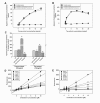When cholesterol is not cholesterol: a note on the enzymatic determination of its concentration in model systems containing vegetable extracts
- PMID: 20565928
- PMCID: PMC2901322
- DOI: 10.1186/1476-511X-9-65
When cholesterol is not cholesterol: a note on the enzymatic determination of its concentration in model systems containing vegetable extracts
Abstract
Background: Experimental evidences demonstrate that vegetable derived extracts inhibit cholesterol absorption in the gastrointestinal tract. To further explore the mechanisms behind, we modeled duodenal contents with several vegetable extracts.
Results: By employing a widely used cholesterol quantification method based on a cholesterol oxidase-peroxidase coupled reaction we analyzed the effects on cholesterol partition. Evidenced interferences were analyzed by studying specific and unspecific inhibitors of cholesterol oxidase-peroxidase coupled reaction. Cholesterol was also quantified by LC/MS. We found a significant interference of diverse (cocoa and tea-derived) extracts over this method. The interference was strongly dependent on model matrix: while as in phosphate buffered saline, the development of unspecific fluorescence was inhibitable by catalase (but not by heat denaturation), suggesting vegetable extract derived H(2)O(2) production, in bile-containing model systems, this interference also comprised cholesterol-oxidase inhibition. Several strategies, such as cholesterol standard addition and use of suitable blanks containing vegetable extracts were tested. When those failed, the use of a mass-spectrometry based chromatographic assay allowed quantification of cholesterol in models of duodenal contents in the presence of vegetable extracts.
Conclusions: We propose that the use of cholesterol-oxidase and/or peroxidase based systems for cholesterol analyses in foodstuffs should be accurately monitored, as important interferences in all the components of the enzymatic chain were evident. The use of adequate controls, standard addition and finally, chromatographic analyses solve these issues.
Figures




Similar articles
-
Determination of total cholesterol content in food by flow injection analysis with immobilized cholesterol oxidase enzyme reactor.Nahrung. 2002 Feb;46(1):46-50. doi: 10.1002/1521-3803(20020101)46:1<46::AID-FOOD46>3.0.CO;2-I. Nahrung. 2002. PMID: 11890055
-
Assessment of sample cleanup and matrix effects in the pesticide residue analysis of foods using postcolumn infusion in liquid chromatography-tandem mass spectrometry.J Chromatogr A. 2011 Nov 18;1218(46):8399-410. doi: 10.1016/j.chroma.2011.09.054. Epub 2011 Sep 28. J Chromatogr A. 2011. PMID: 21999915
-
Effect of hypochlorite oxidation on cholinesterase-inhibition assay of acetonitrile extracts from fruits and vegetables for monitoring traces of organophosphate pesticides.J Toxicol Sci. 2014 Feb;39(1):71-81. doi: 10.2131/jts.39.71. J Toxicol Sci. 2014. PMID: 24418711
-
Mass Spectrometric Approaches for the Analysis of Phytosterols in Biological Samples.J Agric Food Chem. 2017 Nov 29;65(47):10141-10156. doi: 10.1021/acs.jafc.7b03785. Epub 2017 Nov 8. J Agric Food Chem. 2017. PMID: 29058915 Review.
-
Cholesterol oxidase: sources, physical properties and analytical applications.J Steroid Biochem Mol Biol. 2000 Apr;72(5):169-95. doi: 10.1016/s0960-0760(00)00044-3. J Steroid Biochem Mol Biol. 2000. PMID: 10822008 Review.
Cited by
-
Statins Do Not Directly Inhibit the Activity of Major Epigenetic Modifying Enzymes.Cancers (Basel). 2019 Apr 10;11(4):516. doi: 10.3390/cancers11040516. Cancers (Basel). 2019. PMID: 30974899 Free PMC article.
-
The importance of choosing the appropriate cholesterol quantification method: enzymatic assay versus gas chromatography.J Lipid Res. 2024 Jun;65(6):100561. doi: 10.1016/j.jlr.2024.100561. Epub 2024 May 17. J Lipid Res. 2024. PMID: 38762123 Free PMC article.
References
-
- Nagarajan S, Burris RL, Stewart BW, Wilkerson JE, Badger TM. Dietary soy protein isolate ameliorates atherosclerotic lesions in apolipoprotein E-deficient mice potentially by inhibiting monocyte chemoattractant protein-1 expression. J Nutr. 2008;138(2):332–337. - PubMed
Publication types
MeSH terms
Substances
LinkOut - more resources
Full Text Sources
Medical

